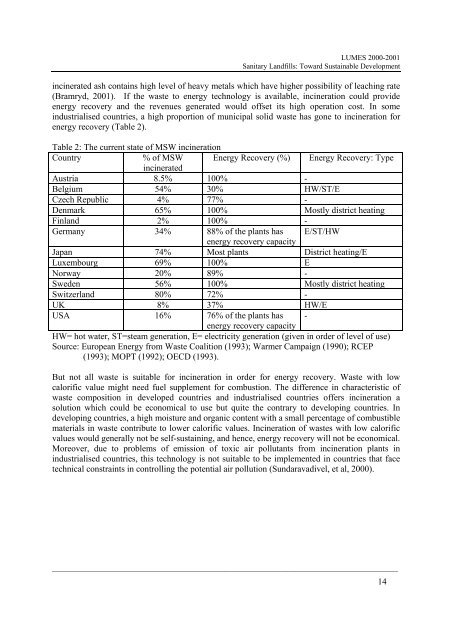Sanitary Landfills: Toward Sustainable Development - lumes
Sanitary Landfills: Toward Sustainable Development - lumes
Sanitary Landfills: Toward Sustainable Development - lumes
Create successful ePaper yourself
Turn your PDF publications into a flip-book with our unique Google optimized e-Paper software.
LUMES 2000-2001<br />
<strong>Sanitary</strong> <strong>Landfills</strong>: <strong>Toward</strong> <strong>Sustainable</strong> <strong>Development</strong><br />
incinerated ash contains high level of heavy metals which have higher possibility of leaching rate<br />
(Bramryd, 2001). If the waste to energy technology is available, incineration could provide<br />
energy recovery and the revenues generated would offset its high operation cost. In some<br />
industrialised countries, a high proportion of municipal solid waste has gone to incineration for<br />
energy recovery (Table 2).<br />
Table 2: The current state of MSW incineration<br />
Country % of MSW<br />
incinerated<br />
Energy Recovery (%) Energy Recovery: Type<br />
Austria 8.5% 100% -<br />
Belgium 54% 30% HW/ST/E<br />
Czech Republic 4% 77% -<br />
Denmark 65% 100% Mostly district heating<br />
Finland 2% 100% -<br />
Germany 34% 88% of the plants has<br />
energy recovery capacity<br />
E/ST/HW<br />
Japan 74% Most plants District heating/E<br />
Luxembourg 69% 100% E<br />
Norway 20% 89% -<br />
Sweden 56% 100% Mostly district heating<br />
Switzerland 80% 72% -<br />
UK 8% 37% HW/E<br />
USA 16% 76% of the plants has<br />
energy recovery capacity<br />
-<br />
HW= hot water, ST=steam generation, E= electricity generation (given in order of level of use)<br />
Source: European Energy from Waste Coalition (1993); Warmer Campaign (1990); RCEP<br />
(1993); MOPT (1992); OECD (1993).<br />
But not all waste is suitable for incineration in order for energy recovery. Waste with low<br />
calorific value might need fuel supplement for combustion. The difference in characteristic of<br />
waste composition in developed countries and industrialised countries offers incineration a<br />
solution which could be economical to use but quite the contrary to developing countries. In<br />
developing countries, a high moisture and organic content with a small percentage of combustible<br />
materials in waste contribute to lower calorific values. Incineration of wastes with low calorific<br />
values would generally not be self-sustaining, and hence, energy recovery will not be economical.<br />
Moreover, due to problems of emission of toxic air pollutants from incineration plants in<br />
industrialised countries, this technology is not suitable to be implemented in countries that face<br />
technical constraints in controlling the potential air pollution (Sundaravadivel, et al, 2000).<br />
______________________________________________________________________________<br />
14

















